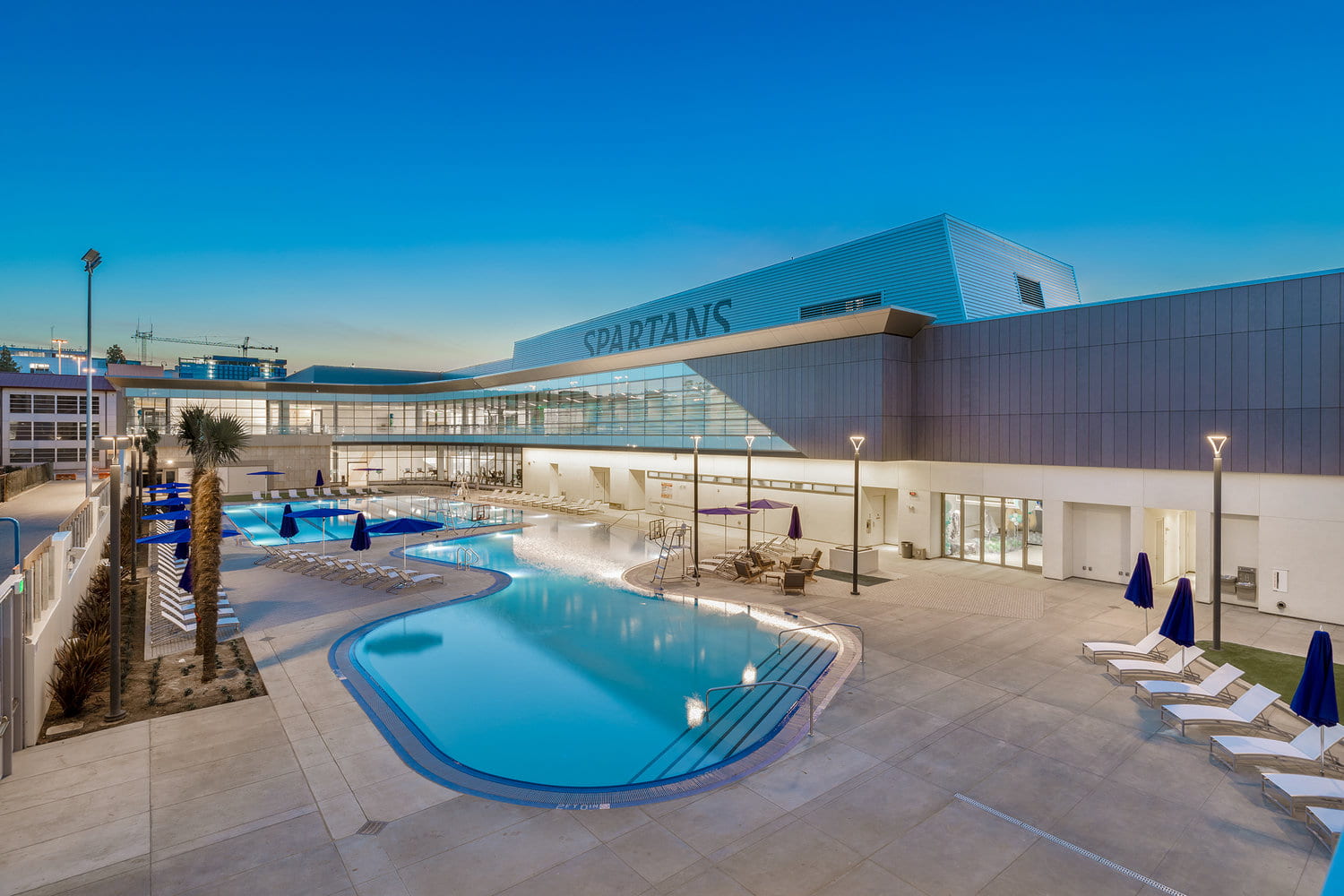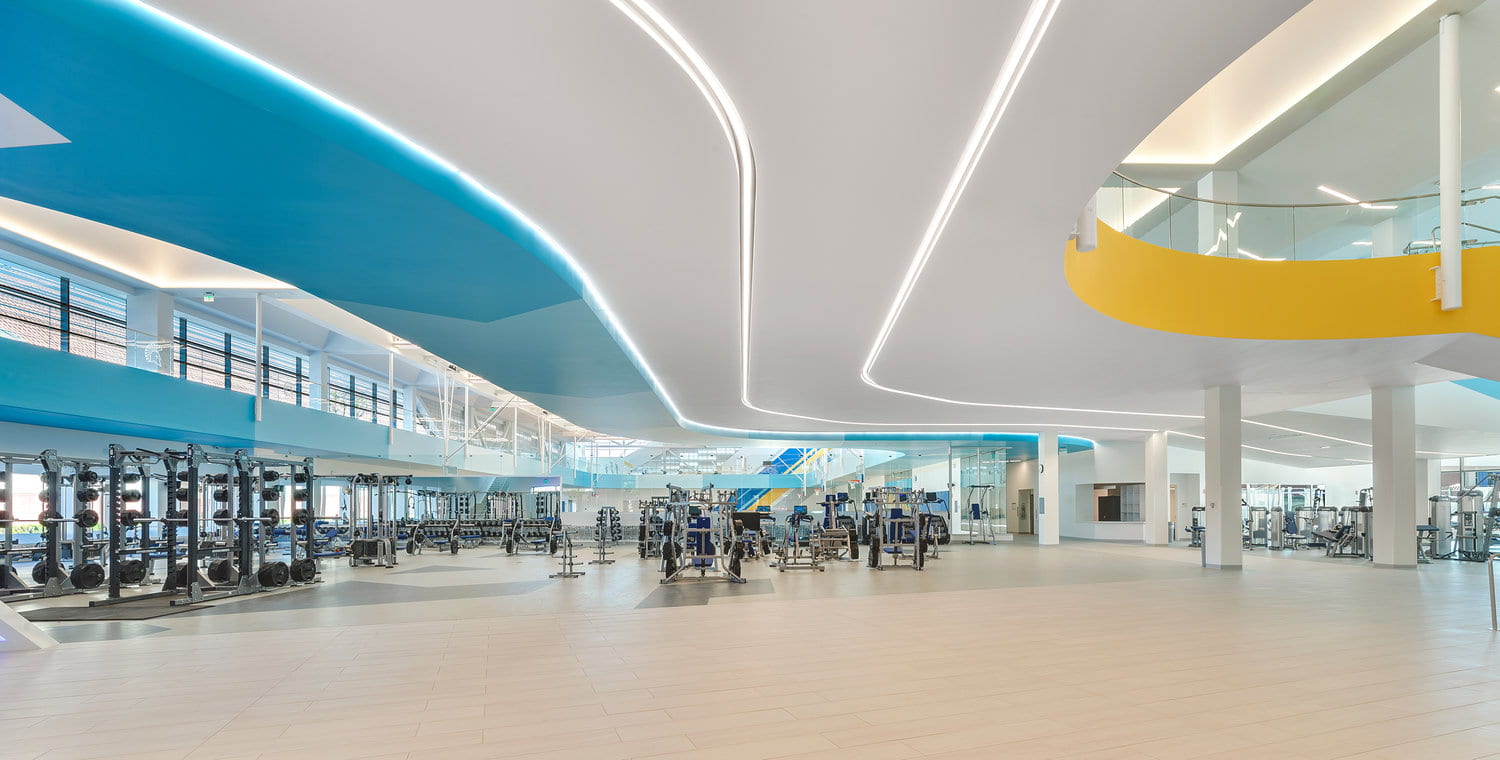For its energy efficiency and green building sustainability achievements, the Student Union at SJSU Spartan Recreation and Aquatic Center (SRAC) received confirmation of its LEED Gold Certification on October 8.
LEED (Leadership in Energy and Environmental Design)—the world standard for green buildings—is a certified rating system offered through the US Green Building Council. SRAC’s LEED Gold certification marks its superior achievement of numerous sustainable and environmental stewardship measures. For example, SRAC met USGBC’s world-class standards for energy savings, water efficiency, CO2 emissions reduction, and indoor environmental quality.
Traci Ferdolage, senior associate vice president for Facilities Development and Operations (FD&O), said “SRAC is a beautiful building and an amazing asset for the campus and the community. But it’s always extra special when we can attain a level of sustainability that contributes over time to our goals around having a lighter footprint. Achieving a LEED Gold certification certainly is something we can point to that aligns with campus and CSU goals around achieving carbon neutrality, as we move forward in the future.”
Tamsen Burke, executive director of the Student Union, Inc. at SJSU who oversees SRAC, Provident Credit Union Event Center, and the Campion Diaz Student Union, said, “Leading the industry in sustainability practices, building construction and design allows us to minimize our carbon footprint by reducing energy, lower operating costs, and creating a healthy environment for the recruitment and retention of employees and prospective students to SJSU.
Ashraf Fouad, FD&O senior director of planning, design and construction, said the long process of achieving the distinction was much more complex than is commonly understood. “LEED Gold certification is not as simple as people might think,” Fouad said. His team examined everything from choosing flooring materials that don’t release volatile organic chemicals to planning an efficient HVAC system for cooling large spaces. “I want to highlight that it’s not easy to do,” he emphasized. “Every decision affects the target.”
LEED certification requires not just green design, but meticulous attention at each stage of construction, Fouad said. Even the handling of the building’s waste construction materials—leftover bits of two-by-four or sheet metal, for example—must be precisely accounted for. Details like vehicle miles driven while disposing of construction waste are counted. The LEED certification process tracked sustainability practices from design through construction, Fouad said. “You have to maintain it throughout, with checkpoints every single step of the way.” Fouad credited “the willingness of our design and construction partners” for their persistence during the process. To win LEED Gold, he said, exhaustive documentation of each sustainability measure is essential, “because maybe you’re doing it—but if you’re not documenting it, it’s not counted.”
Numerous credits toward the Gold certification were awarded in the indoor environmental quality category for SRAC features such as outdoor air delivery monitoring, air circulation, and minimizing dust. Fouad said large gymnasium spaces were challenging because “people generate a lot of heat, playing basketball and so on. We did computer modeling of where that heat is, where you can push and extract air.” Ventilation systems were sited based on the model. Ferdolage said SRAC’s ventilation design efficiently moved warm air away, taking advantage of natural heat flows. Exterior wall vents draw in outside air, and destratification ceiling fans help keep temperature consistent. “It takes a lot of creativity,” she said.
The project received points for its half-mile proximity to public transportation and its accommodations for bicycle parking and storage. Lights activated by motion sensors reduce wasted electricity. Showers and bathroom facilities were designed for water efficiency. To top it off, SRAC’s special roof has a high solar reflectance index—reflecting more than 75 percent of sunshine that hits it—keeping it cooler on the inside. Moreover, Ferdolage said, its roof is an example of how SRAC planners thought carefully about ongoing life cycle costs, with an eye to future savings.
“When they constructed the building, they made it solar ready,” Ferdolage said. “We just now learned of our LEED certification, but through a separate project we’re already starting to install PV panels. The campus didn’t just think about LEED rating points; we plumbed it for future solar, which also demonstrates our commitment to sustainability overall. It’s a wonderful use of that flat roof to further decrease our carbon footprint.” Ferdolage said she was pleased to pass by recently and see workers “on the roof tugging some panels around.” Sustainability improvements are ongoing.
Fouad said, “Our campus user group, stakeholders from the Student Union and others, were very supportive of making the goal a reality.”
Ferdolage said any new CSU building must now achieve LEED Silver equivalency status—but the SRAC planners aspired for more. By achieving Gold, the team far exceeded the CSU minimum. “It demonstrates a commitment by the campus to ensure that it’s taking steps to achieve our carbon neutrality goals,” Ferdolage said. “Not every project in the CSU ends up LEED Gold. It takes a client and a campus valuing the goal. It took leadership and desire. It’s not easy to achieve these levels of certification while also managing a project that meets the budget. It’s something we’re quite proud of.”
“It’s a healthy building,” Fouad said. “You will be healthier inside that building, using it or breathing the air inside. That’s very important, because you will feel it.”
“As operators and managers of SRAC, one of our main responsibilities once you receive the LEED Gold standard is to continue to maintain the life of the building to that standard,” Burke said. “Moreover, strategically, it is how we complement the overall CSU and university sustainability plan which provides a healthier space for students and for the environment.”
LEED-certified buildings not only save resources, they save money and offer the university many economic benefits. From 2015–2018, LEED-certified buildings worldwide saved an estimated $1.2 billion in energy savings, $149.5 million in water savings, $715.3 million in maintenance savings, and $54.2 million in waste savings. Reduced energy use means green buildings also reduce carbon emissions, to help protect the climate. A USGBC scorecard details each LEED points-winning category the SRAC was awarded.
“My hat’s off to the entire SJSU team that worked on this important project,” Ferdolage said, “and for delivering a facility that not only exceeds the CSU goals but also is sustainable into the future with regard to its operation and maintenance lifecycle.”
Fouad added, “As an educational institution, we’re proud that we’re actually practicing what we’re teaching. We teach students how to do better, more thoughtful engineering—of buildings or roads or what have you. So we’re actually practicing that as well.”
Senior Utilities and Sustainability Analyst Debbie Andres said, “the great thing about LEED certification for any of our buildings is that it allows a broad campus coalition to be involved with implementing sustainability at the facility level. Not only is the building an amazing achievement on its own, but we ensured that the building functions as an integral part of the sustainability mission of the whole campus. For example, shower facilities and bike storage are available to our students, faculty and staff to complement biking to campus efforts. Recycled water usage was expanded to use for irrigation and will be used in toilets. Educational materials and signage will be available for students to learn about environmentally friendly buildings. And construction waste was virtually all diverted, contributing to our zero waste efforts. We even show that green cleaning procedures that are in place for the campus are in place for the SRAC.”
A 128,000-square-foot state-of-the-art facility for reaching and maintaining fitness goals, SRAC has three full-court gyms for basketball, volleyball, badminton and more, four fitness studios, an indoor track, a climbing wall and bouldering area, and a 50-meter lap pool. SRAC’s Gold certification recognized not only its electricity savings, water savings and maintenance savings—but also the design innovations that amplify the sensory human experience of using the space.


